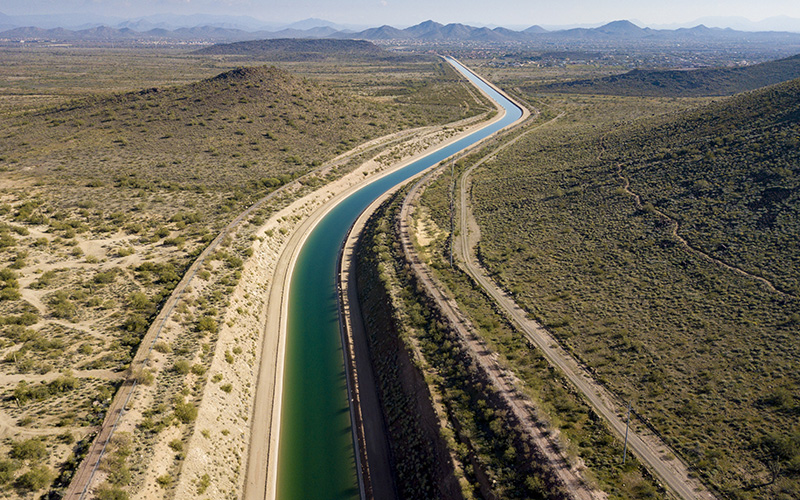
The Central Arizona Project carries Colorado River water into the Phoenix area and is the single largest component of the Gila River Indian Community’s water rights. The tribe recently announced plans to conserve more water in exchange for federal payments. (Photo by Ted Wood/The Water Desk, University of Colorado)
The Gila River Indian Community has announced plans to conserve a large portion of its water supplies over the next three years and is seeking payment from a new federal program designed to incentivize such reductions. This marks a reversal from an August announcement that the tribe would pull out of conservation efforts.
The tribe will conserve up to 750,000 acre-feet over the next three years, which will be used to help prop up overtaxed Lake Mead.
Water levels in Mead, the nation’s largest reservoir, are at record lows, and a supply-demand imbalance along the Colorado River is driving them even lower. A two-decade-long megadrought, fueled by climate change, has prompted urgent calls for water conservation around the arid Southwest, which is home to 40 million people.
Gila River is taking advantage of a recently-launched payment program from the Bureau of Reclamation, which manages water resources in the West.
The agency began fielding proposals for conservation plans from water users a few months after the seven states that rely on the Colorado River failed to cut back usage by a federal deadline. The federal government will pay those users – mainly farmers, many of them in central Arizona – $330 to $400 per acre-foot if they can explain how they will make and measure cutbacks. Those funds will come out of the Inflation Reduction Act, $4 billion of which was designated for drought mitigation in the vast Colorado River Basin.
Colorado River water, delivered by the Central Arizona Project, is the single largest component of the Gila River Indian Community’s water rights.
Earlier this summer, the tribe pulled out of conservation agreements, with Gov. Stephen Roe Lewis saying he was “shocked and disappointed” that other water users had declined to cooperate.
“We cannot continue to put the interests of all others above our own when no other parties seem committed to the common goal of a cooperative basin-wide agreement,” he said in an August statement.
Growers in Lower Basin states, including Arizona and California, were proposing conservation measures in which they would receive upwards of $1,000 per acre-foot from the Bureau of Reclamation.
Sarah Porter, director of the Kyl Center for Water Policy at Arizona State University, said the Gila River tribe now is resuming conservation because a price has been set on conserved water.
“Certainly, there’s rational financial decisionmaking here,” Porter said. “But there is a moral leadership here. From their perspective, there’s a moral issue about how water is priced and that different parties should be getting the same deal.”
Jason Hauter, a lawyer representing the Gila River Indian Community, said the tribe was encouraged by a new conservation plan released by three water agencies in Southern California, a signal that “others were taking this crisis seriously or trying to do something.”
Hauter, who’s a member of the Gila River community, said the tribe was also motivated by Reclamation shifting its efforts toward funding long-term infrastructure projects and not just short-term payouts for water conservation.
“We want to be good actors,” Lewis said. “We want to make sure that the precious water supplies we have, that it’s going to go to a sustainable solution.”
Porter said the tribe’s contributions involve a significant amount of water. By comparison, three agencies in Southern California, which account for some of the largest water allocations in the Colorado River Basin, said they would conserve 400,000 acre-feet each year.
“The Gila River Indian Community deciding to offer to conserve substantial amounts of water means that we have a better opportunity to keep negotiations on track to get to the deal that we need to get to,” Porter said. “Shifting the momentum and making a decision to move in the direction of getting to a deal is a leadership move, and I would say kind of a morally positive move, because getting to a deal is really critical for everyone who shares Colorado River water.”
Recent water conservation agreements are set against the backdrop of basin-wide renegotiations for how the Colorado River is shared. Current rules for water use are set to expire in 2026, and the seven states that use the river’s water are beginning the process of drawing up new guidelines.
As climate change has crippled the nation’s largest reservoirs, a patchwork of short-term conservation agreements has emerged to prevent catastrophe before 2026.
The Colorado River Basin includes 30 federally-recognized Indian tribes. Those tribes hold rights to about a quarter of the river’s flow, but have often been excluded from negotiations about how the river’s water is used. At the same time, tribal communities often lack reliable access to clean water because of aging infrastructure and a history of underinvestment.
Tribes are calling for greater inclusion as the basin gears up for negotiations leading up to 2026. In August, the Gila River Indian Community was among the 14 tribes that signed a letter saying they had been left “in the dark” during midsummer conservation talks.
This story is part of ongoing coverage of the Colorado River, produced by KUNC, and supported by the Walton Family Foundation.